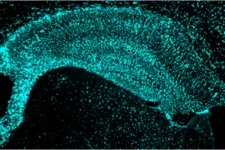(Press-News.org) A computerized brain implant effectively relieves short-term and chronic pain in rodents, a new study finds.
The experiments, conducted by investigators at NYU Grossman School of Medicine, offer what the researchers call a "blueprint" for the development of brain implants to treat pain syndromes and other brain-based disorders, such as anxiety, depression, and panic attacks.
Publishing June 21 in the journal Nature Biomedical Engineering, the study showed that device-implanted rats withdrew their paws 40 percent more slowly from sudden pain compared with times when their device was turned off.
According to the study authors, this suggests that the device reduced the intensity of the pain the rodents experienced. In addition, animals in sudden or continuous pain spent about two-thirds more time in a chamber where the computer-controlled device was turned on than in a chamber where it was not.
Researchers say the investigation is the first to use a computerized brain implant to detect and relieve bursts of pain in real time. The device is also the first of its kind to target chronic pain, which often occurs without being prompted by a known trigger, the study authors say.
"Our findings show that this implant offers an effective strategy for pain therapy, even in cases where symptoms are traditionally difficult to pinpoint or manage," says senior study author Jing Wang, MD, PhD, the Valentino D.B. Mazzia, MD, JD Associate Professor in the Department of Anesthesiology at NYU Langone Health.
Chronic pain is estimated to affect one in four adults in the United States, yet until now, safe and reliable treatments have proven elusive, says Wang, also the Vice Chair for Clinical and Translational Research at NYU Langone. Particularly for pain that keeps coming back, current therapies such as opioids often grow less effective over time as people become desensitized to the treatment. In addition, drugs such as opioids activate the reward centers of the brain to create feelings of pleasure that may lead to addiction.
Computerized brain implants, previously investigated to prevent epileptic seizures and control prosthetic devices, may avert many of these issues, says Wang. The technology, known as a closed-loop brain-machine interface, detects brain activity in the anterior cingulate cortex, a region of the brain that is critical for pain processing. A computer linked to the device then automatically identifies electrical patterns in the brain closely linked to pain. When signs of pain are detected, the computer triggers therapeutic stimulation of another region of the brain, the prefrontal cortex, to ease it.
Since the device is only activated in the presence of pain, Wang says, it lessens the risk of overuse and any potential for tolerance to develop. Furthermore, because the implant does not offer a reward beyond pain relief, as opioids do, the risk of addiction is minimized.
As part of the study, the researchers installed tiny electrodes in the brains of dozens of rats and then exposed them to carefully measured amounts of pain. The animals were closely monitored for how quickly they moved away from the pain source. This allowed the investigators to track how often the device correctly identified pain-based brain activity in the anterior cingulate cortex and how effectively it could lessen the resulting sensation.
According to the study authors, the implant accurately detected pain up to 80 percent of the time.
"Our results demonstrate that this device may help researchers better understand how pain works in the brain," says lead study investigator Qiaosheng Zhang, PhD, a doctoral fellow in the Department of Anesthesiology, Perioperative Care and Pain at NYU Langone. "Moreover, it may allow us to find non-drug therapies for other neuropsychiatric disorders, such as anxiety, depression, and post-traumatic stress."
Zhang adds that the implant's pain-detection properties could be improved by installing electrodes in other regions of the brain beyond the anterior cingulate cortex. He cautions, however, that the technology is not yet suitable for use in people, but says plans are underway to investigate less-invasive forms with potential to be adapted for human use.
INFORMATION:
Funding for the study was provided by National Institutes of Health grants R01 NS100065, R01 GM115384, and R01 MH118928, and National Science Foundation grant CBET 1835000.
In addition to Wang and Zhang, other NYU Langone researchers included Sile Hu, MS; Robert Talay; Amrita Singh, BA; Bassir Caravan, BS; Zhengdong Xiao, MS; David Rosenberg, BS; Anna Li, BM; Johnathan D. Gould; Yaling Liu; Guanghao Sun; and Zhe S. Chen, PhD.
Media Inquiries
Shira Polan
212-404-4279
shira.polan@nyulangone.org
Engineers at Tufts University have developed new methods to more efficiently fabricate materials that behave in unusual ways when interacting with microwave energy, with potential implications for telecommunications, GPS, radar, mobile devices, and medical devices. Known as metamaterials, they are sometimes referred to as "impossible materials" because they could, in theory, bend energy around objects to make them appear invisible, concentrate the transmission of energy into focused beams, or have chameleon like abilities to reconfigure their absorption or transmission of different frequency ranges.
The innovation, described today in Nature Electronics, constructs the metamaterials using ...
CAMBRIDGE, MA -- Every year, about 400,000 people receive silicone breast implants in the United States. According to data from the U.S. Food and Drug Administration, a majority of those implants needs to be replaced within 10 years due to the buildup of scar tissue and other complications.
A team led by MIT researchers has now systematically analyzed how the varying surface architecture found in these implants influences the development of adverse effects, which in rare cases can include an unusual type of lymphoma.
"The surface topography of an implant can drastically affect how the immune response perceives it, and this has important ramifications for the [implants'] design," says Omid Veiseh, a former MIT postdoc. "We ...
Researchers at the University of Bristol have discovered a method which will allow for faster communication systems and better energy saving electronics.
The breakthrough was made by establishing how to remotely measure the electric field inside a semiconductor device for the first time. A semiconductor is a material, such as Silicon, which can be used in electronic devices to control electric current.
Now, in this new study, published today in Nature Electronics, scientists outline how to precisely quantify this electric field, meaning next generation power and radio frequency electronic devices can be developed which have the potential to be faster, and more reliable, as well as more energy ...
A process using a light-sensitive chemical can drastically reduce cost and energy consumption to produce gamma-cyclodextrin, a compound that is widely used in manufacturing, according to a Dartmouth study.
The research, published in Chem, demonstrates how a hydrazone template can replace energy-intensive distillation to produce and isolate gamma-cyclodextrin--a water-soluble chemical that attracts other molecules and is used to enhance food, pharmaceuticals, and a wide range of consumer products.
"These compounds are biodegradable, biocompatible, benign and commonly used," said Ivan Aprahamian, a professor of chemistry at Dartmouth. "We are making ...
By the time people with Alzheimer's disease start exhibiting difficulty remembering and thinking, the disease has been developing in their brains for two decades or more, and their brain tissue already has sustained damage. As the disease progresses, the damage accumulates, and their symptoms worsen.
Researchers at Washington University School of Medicine in St. Louis have found that high levels of a normal protein associated with reduced heart disease also protect against Alzheimer's-like brain damage - at least in mice. The findings, published June 21 in Neuron, suggest that raising levels ...
An investigational Alzheimer's drug reduced molecular markers of disease and curbed neurodegeneration in the brain, without demonstrating evidence of cognitive benefit, in a phase 2/3 clinical trial led by researchers at Washington University School of Medicine in St. Louis through its Dominantly Inherited Alzheimer Network-Trials Unit (DIAN-TU). These results led the trial leaders to offer the drug, known as gantenerumab, to participants as part of an exploratory open-label extension. The researchers continue to monitor changes in measures of Alzheimer's disease in those participants who are receiving the drug.
The DIAN-TU study (ClinicalTrials.gov Identifier: NCT01760005), published June 21 in Nature Medicine, evaluated the effects of two investigational drugs - ...
In the mid-2030s, multiple United States coastal regions may see rapid increases in the number of high-tide flooding (HTF) days, according to a study led by the University of Hawai'i at Mānoa and published today in Nature Climate Change. The combined effects of sea-level rise (SLR) and natural fluctuations in tidal range are anticipated to cause tipping points in the frequency of HTF.
Coastal locations around the U.S., particularly along the Atlantic coast, are experiencing recurrent flooding at high tide. The impact of HTF accumulates over numerous seemingly minor occurrences, which can exceed the impact of rare extremes over time. These impacts are subtle--for example, the loss of revenue due to recurrent road and business closures--compared with the physical damage of property ...
Scientists studying a common childhood cancer have made a major breakthrough which could lead to a cure for some youngsters who would not have survived the condition.
An international study, involving Newcastle University, UK, has for the first time found a genetic marker in tumours from patients with high-risk neuroblastoma.
Research, published in the Journal of Clinical Oncology, has identified that alterations in the neuroblastoma's ALK (anaplastic lymphoma kinase) gene are associated with a significantly poorer prognosis for children with high-risk disease.
Experts ...
Drugs routinely used during fertility treatments to release eggs do not increase the risk of developing breast cancer, new research has shown.
Researchers from King's College London, in partnership with King's Fertility, analysed studies involving 1.8 million women undergoing fertility treatments. These women were followed up in studies for an average period of 27 years and had no increase in the risk of developing breast cancer.
The research, published today in Fertility and Sterility journal, is the largest study to date assessing whether commonly used fertility drugs are for a cancer risk for women.
Fertility treatments can range from using medications to boost the release of an egg in a women's natural cycle to more complex ...
A study by the University of Liverpool has shown that while asymptomatic COVID-19 testing in Liverpool was popular, significant inequalities were evident between those who got tested and those who didn't.
Published in the journal The Lancet Regional Health - Europe, the study found that 43% of residents aged over 5 years (n = 214 525) took up the offer of free testing for people without symptoms of COVID-19 between 6th November 2020 and 31st January 2021. A total of 1.3% of tests were positive, meaning that 5192 individuals who did not know they had the virus were notified ...





